Abstract
The normal precursor of the neoplastic cell in Hodgkin's lymphoma is still unknown. Previous reports on the expression of the Hodgkin's cell-associated antigen Ki-1, CD30, on normal cells have been limited to activated lymphocytes. This study demonstrates, however, that cells of the macrophage lineage also are able to express the Ki-1 antigen. The Ki-1 antigen is absent from normal blood monocytes but expressed on up to 85% of macrophage-type cells developed during subsequent in vitro differentiation on Teflon membranes. Unlike other maturation-associated antigens, Ki-1 is found only at late stages of the macrophage primary cultures. Its expression can be enhanced by human interferon-gamma in a fashion similar to that of HLA-DR molecules. In addition, freshly explanted tumor cells from three patients with histopathologic and clinical features consistent with the diagnosis of true histiocytic lymphoma or malignant histiocytosis as well as the permanent cell line SU-DHL-1 could be demonstrated to express the Ki-1 antigen. The phenotype of histiocytic malignancy was further evaluated to be HLA-DR+MAX.26+CD25+-EMA+OKT9+Ki-1+. The results could indicate either that Hodgkin's lymphoma may arise not only from the lymphocyte but also from the macrophage lineage or may emphasize a macrophage involvement in the pathogenesis of this disease.
Full text
PDF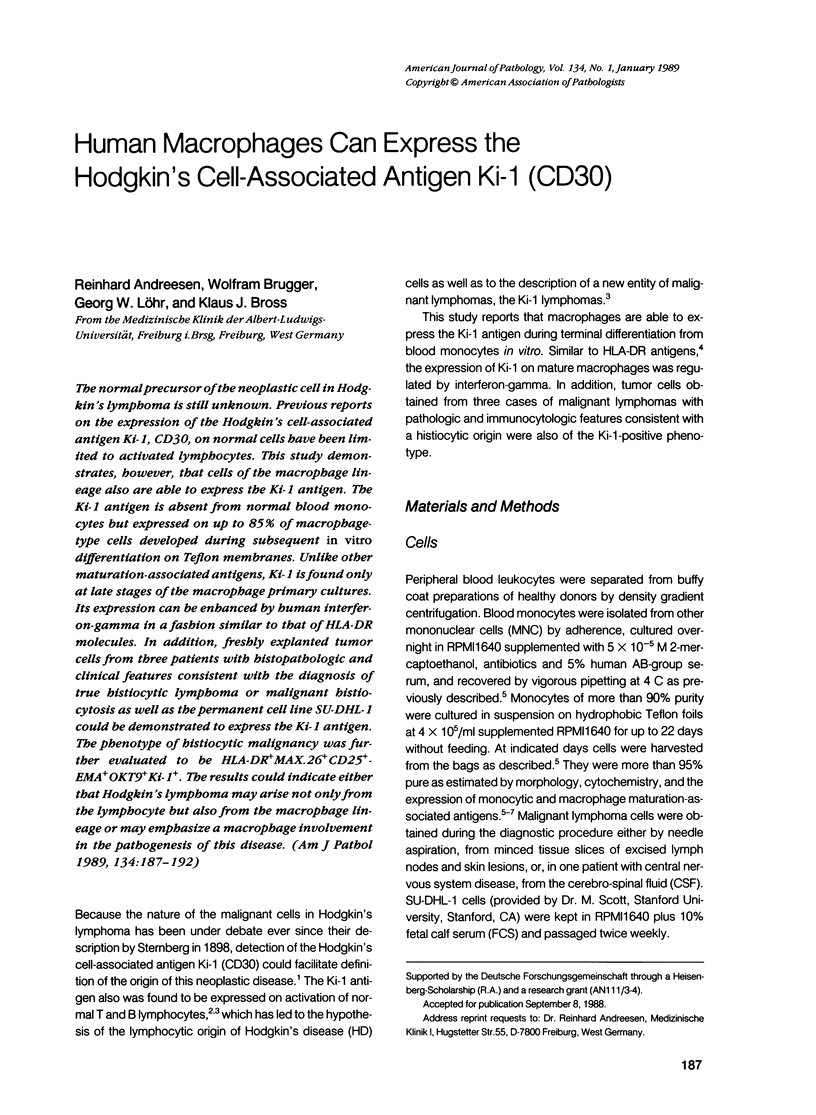
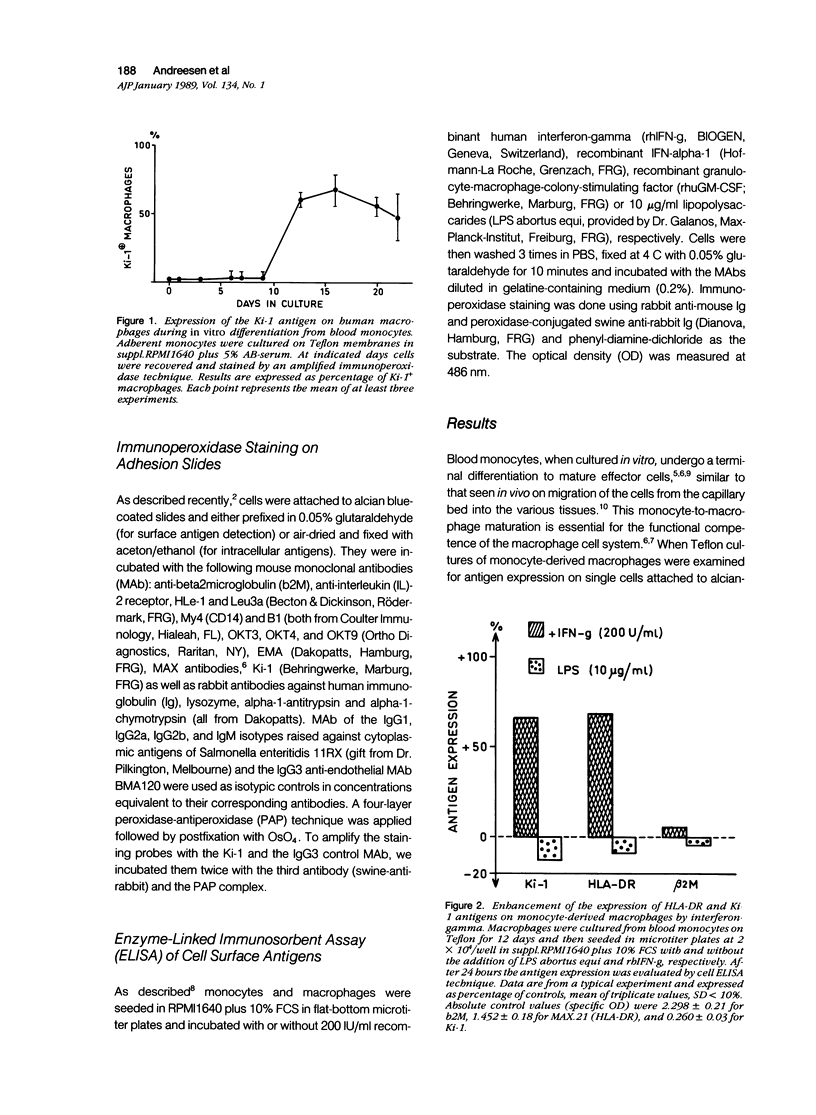
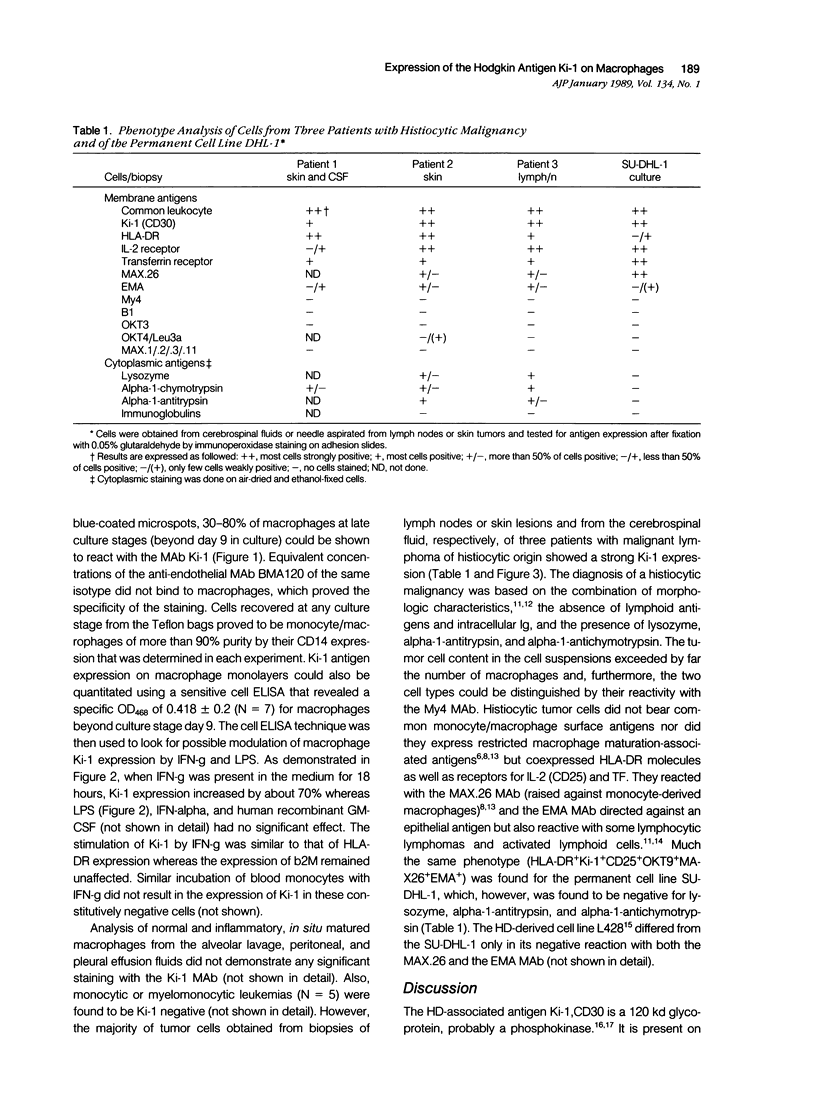
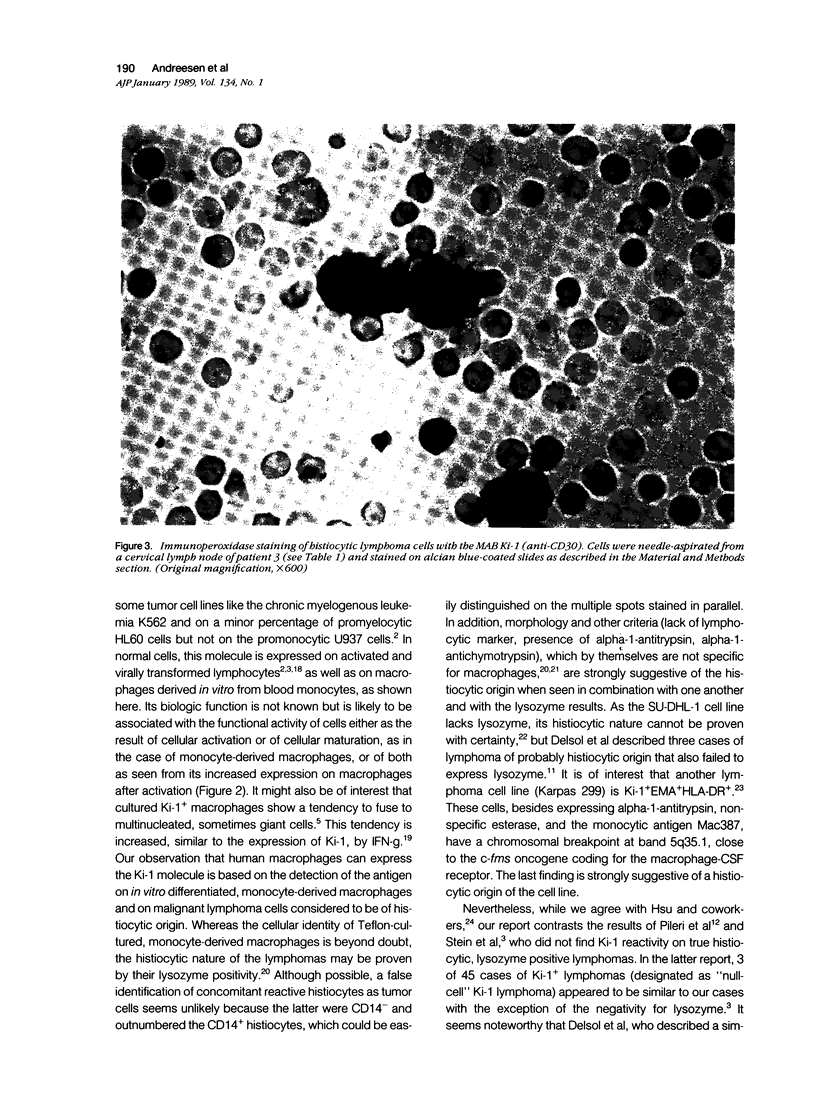
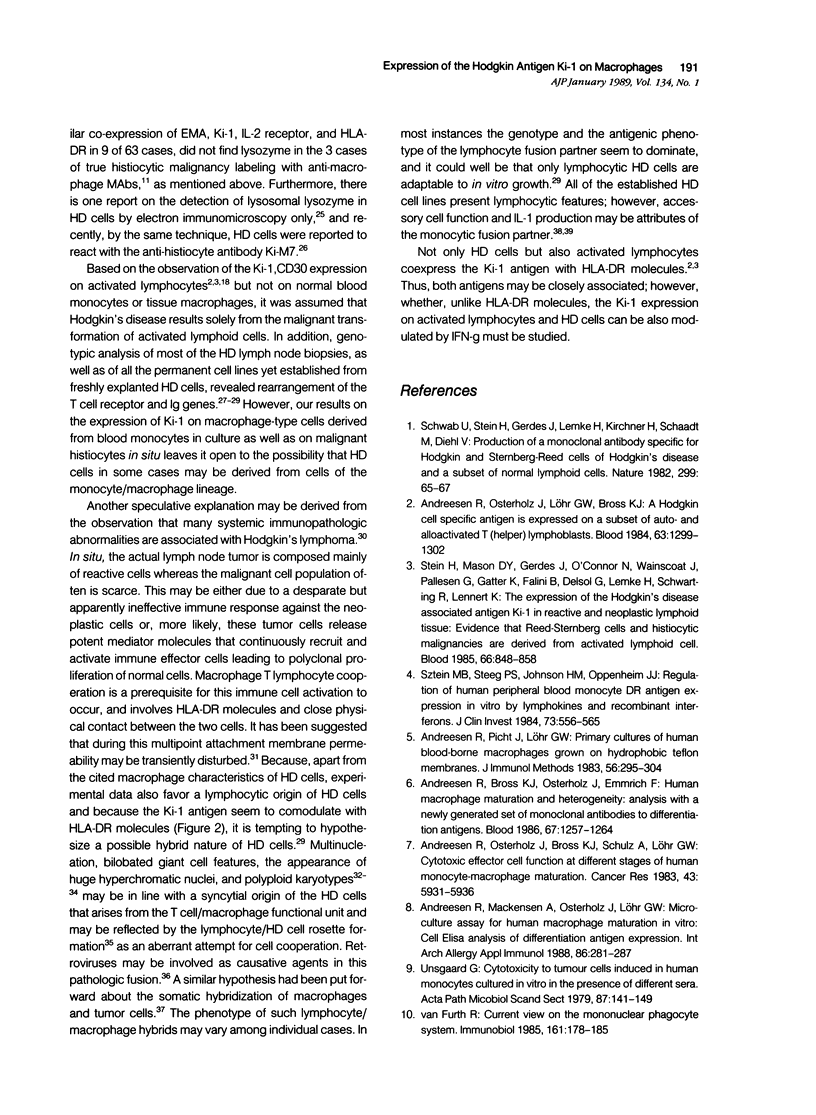
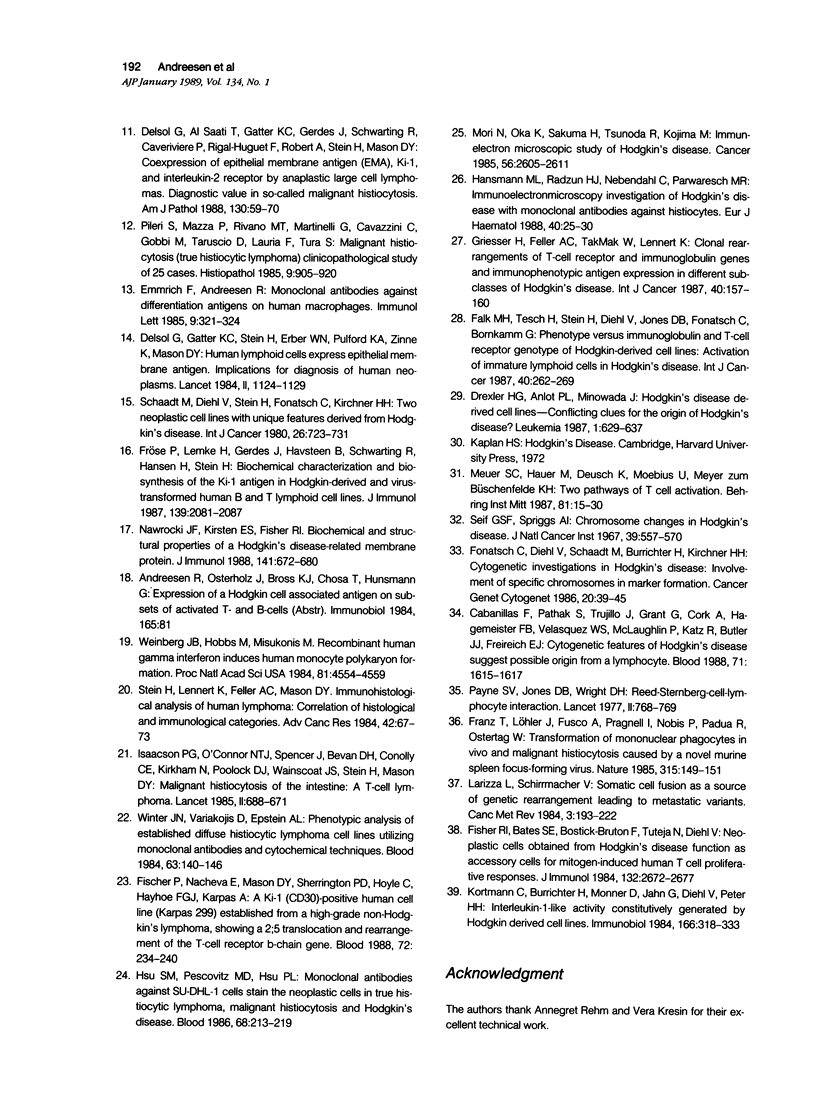
Images in this article
Selected References
These references are in PubMed. This may not be the complete list of references from this article.
- Andreesen R., Bross K. J., Osterholz J., Emmrich F. Human macrophage maturation and heterogeneity: analysis with a newly generated set of monoclonal antibodies to differentiation antigens. Blood. 1986 May;67(5):1257–1264. [PubMed] [Google Scholar]
- Andreesen R., Mackensen A., Osterholz J., Brugger W., Löhr G. W. Microculture assay for human macrophage maturation in vitro. Cell-ELISA analysis of differentiation antigen expression. Int Arch Allergy Appl Immunol. 1988;86(3):281–287. doi: 10.1159/000234585. [DOI] [PubMed] [Google Scholar]
- Andreesen R., Osterholz J., Bross K. J., Schulz A., Luckenbach G. A., Löhr G. W. Cytotoxic effector cell function at different stages of human monocyte-macrophage maturation. Cancer Res. 1983 Dec;43(12 Pt 1):5931–5936. [PubMed] [Google Scholar]
- Andreesen R., Osterholz J., Löhr G. W., Bross K. J. A Hodgkin cell-specific antigen is expressed on a subset of auto- and alloactivated T (helper) lymphoblasts. Blood. 1984 Jun;63(6):1299–1302. [PubMed] [Google Scholar]
- Andreesen R., Picht J., Löhr G. W. Primary cultures of human blood-born macrophages grown on hydrophobic teflon membranes. J Immunol Methods. 1983 Feb 11;56(3):295–304. doi: 10.1016/s0022-1759(83)80019-2. [DOI] [PubMed] [Google Scholar]
- Cabanillas F., Pathak S., Trujillo J., Grant G., Cork A., Hagemeister F. B., Velasquez W. S., McLaughlin P., Redman J., Katz R. Cytogenetic features of Hodgkin's disease suggest possible origin from a lymphocyte. Blood. 1988 Jun;71(6):1615–1617. [PubMed] [Google Scholar]
- Delsol G., Al Saati T., Gatter K. C., Gerdes J., Schwarting R., Caveriviere P., Rigal-Huguet F., Robert A., Stein H., Mason D. Y. Coexpression of epithelial membrane antigen (EMA), Ki-1, and interleukin-2 receptor by anaplastic large cell lymphomas. Diagnostic value in so-called malignant histiocytosis. Am J Pathol. 1988 Jan;130(1):59–70. [PMC free article] [PubMed] [Google Scholar]
- Delsol G., Gatter K. C., Stein H., Erber W. N., Pulford K. A., Zinne K., Mason D. Y. Human lymphoid cells express epithelial membrane antigen. Implications for diagnosis of human neoplasms. Lancet. 1984 Nov 17;2(8412):1124–1129. doi: 10.1016/s0140-6736(84)91558-7. [DOI] [PubMed] [Google Scholar]
- Drexler H. G., Amlot P. L., Minowada J. Hodgkin's disease-derived cell lines--conflicting clues for the origin of Hodgkin's disease? Leukemia. 1987 Sep;1(9):629–637. [PubMed] [Google Scholar]
- Emmrich F., Andreesen R. Monoclonal antibodies against differentiation antigens on human macrophages. Immunol Lett. 1985;9(6):321–324. doi: 10.1016/0165-2478(85)90056-2. [DOI] [PubMed] [Google Scholar]
- Falk M. H., Tesch H., Stein H., Diehl V., Jones D. B., Fonatsch C., Bornkamm G. W. Phenotype versus immunoglobulin and T-cell receptor genotype of Hodgkin-derived cell lines: activation of immature lymphoid cells in Hodgkin's disease. Int J Cancer. 1987 Aug 15;40(2):262–269. doi: 10.1002/ijc.2910400223. [DOI] [PubMed] [Google Scholar]
- Fischer P., Nacheva E., Mason D. Y., Sherrington P. D., Hoyle C., Hayhoe F. G., Karpas A. A Ki-1 (CD30)-positive human cell line (Karpas 299) established from a high-grade non-Hodgkin's lymphoma, showing a 2;5 translocation and rearrangement of the T-cell receptor beta-chain gene. Blood. 1988 Jul;72(1):234–240. [PubMed] [Google Scholar]
- Fisher R. I., Bates S. E., Bostick-Bruton F., Tuteja N., Diehl V. Neoplastic cells obtained from Hodgkin's disease function as accessory cells for mitogen-induced human T cell proliferative responses. J Immunol. 1984 May;132(5):2672–2677. [PubMed] [Google Scholar]
- Fonatsch C., Diehl V., Schaadt M., Burrichter H., Kirchner H. H. Cytogenetic investigations in Hodgkin's disease: I. Involvement of specific chromosomes in marker formation. Cancer Genet Cytogenet. 1986 Feb 1;20(1-2):39–52. doi: 10.1016/0165-4608(86)90106-8. [DOI] [PubMed] [Google Scholar]
- Franz T., Löhler J., Fusco A., Pragnell I., Nobis P., Padua R., Ostertag W. Transformation of mononuclear phagocytes in vivo and malignant histiocytosis caused by a novel murine spleen focus-forming virus. Nature. 1985 May 9;315(6015):149–151. doi: 10.1038/315149a0. [DOI] [PubMed] [Google Scholar]
- Froese P., Lemke H., Gerdes J., Havsteen B., Schwarting R., Hansen H., Stein H. Biochemical characterization and biosynthesis of the Ki-1 antigen in Hodgkin-derived and virus-transformed human B and T lymphoid cell lines. J Immunol. 1987 Sep 15;139(6):2081–2087. [PubMed] [Google Scholar]
- Griesser H., Feller A. C., Mak T. W., Lennert K. Clonal rearrangements of T-cell receptor and immunoglobulin genes and immunophenotypic antigen expression in different subclasses of Hodgkin's disease. Int J Cancer. 1987 Aug 15;40(2):157–160. doi: 10.1002/ijc.2910400205. [DOI] [PubMed] [Google Scholar]
- Hansmann M. L., Radzun H. J., Nebendahl C., Parwaresch M. R. Immunoelectronmicroscopic investigation of Hodgkin's disease with monoclonal antibodies against histiocytes. Eur J Haematol. 1988 Jan;40(1):25–30. doi: 10.1111/j.1600-0609.1988.tb00792.x. [DOI] [PubMed] [Google Scholar]
- Hsu S. M., Pescovitz M. D., Hsu P. L. Monoclonal antibodies against SU-DHL-1 cells stain the neoplastic cells in true histiocytic lymphoma, malignant histiocytosis, and Hodgkin's disease. Blood. 1986 Jul;68(1):213–219. [PubMed] [Google Scholar]
- Isaacson P. G., O'Connor N. T., Spencer J., Bevan D. H., Connolly C. E., Kirkham N., Pollock D. J., Wainscoat J. S., Stein H., Mason D. Y. Malignant histiocytosis of the intestine: a T-cell lymphoma. Lancet. 1985 Sep 28;2(8457):688–691. doi: 10.1016/s0140-6736(85)92930-7. [DOI] [PubMed] [Google Scholar]
- Kortmann C., Burrichter H., Monner D., Jahn G., Diehl V., Peter H. H. Interleukin-1-like activity constitutively generated by Hodgkin derived cell lines. I. Measurement in a human lymphocyte co-stimulator assay. Immunobiology. 1984 May;166(3):318–333. doi: 10.1016/s0171-2985(84)80049-2. [DOI] [PubMed] [Google Scholar]
- Larizza L., Schirrmacher V. Somatic cell fusion as a source of genetic rearrangement leading to metastatic variants. Cancer Metastasis Rev. 1984;3(3):193–222. doi: 10.1007/BF00048385. [DOI] [PubMed] [Google Scholar]
- Meuer S. C., Hauer M., Deusch K., Moebius U., Meyer zum Büschenfelde K. H. Two pathways of T cell activation. Behring Inst Mitt. 1987 Jun;(81):15–30. [PubMed] [Google Scholar]
- Mori N., Oka K., Sakuma H., Tsunoda R., Kojima M. Immunoelectron microscopic study of Hodgkin's disease. Cancer. 1985 Dec 1;56(11):2605–2611. doi: 10.1002/1097-0142(19851201)56:11<2605::aid-cncr2820561112>3.0.co;2-2. [DOI] [PubMed] [Google Scholar]
- Nawrocki J. F., Kirsten E. S., Fisher R. I. Biochemical and structural properties of a Hodgkin's disease-related membrane protein. J Immunol. 1988 Jul 15;141(2):672–680. [PubMed] [Google Scholar]
- Payne S. V., Jones D. B., Wright D. H. Reed-Sternberg-cell/lymphocyte interaction. Lancet. 1977 Oct 8;2(8041):768–769. doi: 10.1016/s0140-6736(77)90281-1. [DOI] [PubMed] [Google Scholar]
- Pileri S., Mazza P., Rivano M. T., Martinelli G., Cavazzini G., Gobbi M., Taruscio D., Lauria F., Tura S. Malignant histiocytosis (true histiocytic lymphoma) clinicopathological study of 25 cases. Histopathology. 1985 Sep;9(9):905–920. doi: 10.1111/j.1365-2559.1985.tb02877.x. [DOI] [PubMed] [Google Scholar]
- Schaadt M., Diehl V., Stein H., Fonatsch C., Kirchner H. H. Two neoplastic cell lines with unique features derived from Hodgkin's disease. Int J Cancer. 1980 Dec 15;26(6):723–731. doi: 10.1002/ijc.2910260605. [DOI] [PubMed] [Google Scholar]
- Schwab U., Stein H., Gerdes J., Lemke H., Kirchner H., Schaadt M., Diehl V. Production of a monoclonal antibody specific for Hodgkin and Sternberg-Reed cells of Hodgkin's disease and a subset of normal lymphoid cells. Nature. 1982 Sep 2;299(5878):65–67. doi: 10.1038/299065a0. [DOI] [PubMed] [Google Scholar]
- Seif G. S., Spriggs A. I. Chromosome changes in Hodgkin's disease. J Natl Cancer Inst. 1967 Sep;39(3):557–570. [PubMed] [Google Scholar]
- Stein H., Mason D. Y., Gerdes J., O'Connor N., Wainscoat J., Pallesen G., Gatter K., Falini B., Delsol G., Lemke H. The expression of the Hodgkin's disease associated antigen Ki-1 in reactive and neoplastic lymphoid tissue: evidence that Reed-Sternberg cells and histiocytic malignancies are derived from activated lymphoid cells. Blood. 1985 Oct;66(4):848–858. [PubMed] [Google Scholar]
- Sztein M. B., Steeg P. S., Johnson H. M., Oppenheim J. J. Regulation of human peripheral blood monocyte DR antigen expression in vitro by lymphokines and recombinant interferons. J Clin Invest. 1984 Feb;73(2):556–565. doi: 10.1172/JCI111243. [DOI] [PMC free article] [PubMed] [Google Scholar]
- Unsgaard G. Cytotoxicity to tumour cells induced in human monocytes cultured in vitro in the presence of different sera. Acta Pathol Microbiol Scand C. 1979 Apr;87C(2):141–149. [PubMed] [Google Scholar]
- Weinberg J. B., Hobbs M. M., Misukonis M. A. Recombinant human gamma-interferon induces human monocyte polykaryon formation. Proc Natl Acad Sci U S A. 1984 Jul;81(14):4554–4557. doi: 10.1073/pnas.81.14.4554. [DOI] [PMC free article] [PubMed] [Google Scholar]
- Winter J. N., Variakojis D., Epstein A. L. Phenotypic analysis of established diffuse histiocytic lymphoma cell lines utilizing monoclonal antibodies and cytochemical techniques. Blood. 1984 Jan;63(1):140–146. [PubMed] [Google Scholar]
- van Furth R. Current view on the mononuclear phagocyte system. Immunobiology. 1982 Apr;161(3-4):178–185. doi: 10.1016/S0171-2985(82)80072-7. [DOI] [PubMed] [Google Scholar]



